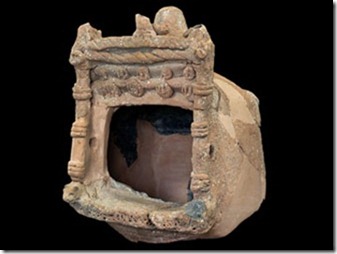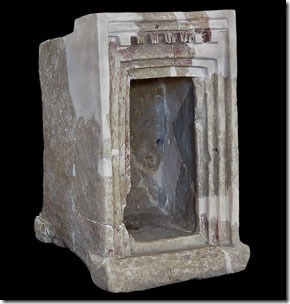Recent discoveries of a cultic significance were announced today in a press conference at Hebrew University. Archaeologists Yosef Garfinkel and Saar Ganor believe that they have found religious objects from the time of King David at Khirbet Qeiyafa in the Shephelah of Judah.
The three shrines are part of larger building complexes. In this respect they are different from Canaanite or Philistine cults, which were practiced in temples – separate buildings dedicated only to rituals. The biblical tradition described this phenomenon in the time of King David: “He brought the ark of God from a private house in Kyriat Yearim and put it in Jerusalem in a private house” (2 Samuel 6).
The cult objects include five standing stones (Massebot), two basalt altars, two pottery libation vessels and two portable shrines. No human or animal figurines were found, suggesting the people of Khirbet Qeiyafa observed the biblical ban on graven images.
The two portable shrines are of great interest and may help us to understand some difficult terms in the Hebrew Bible.
Two portable shrines (or “shrine models”) were found, one made of pottery (ca. 20 cm high) and the other of stone (35 cm high). These are boxes in the shape of temples, and could be closed by doors.
The clay shrine is decorated with an elaborate façade, including two guardian lions, two pillars, a main door, beams of the roof, folded textile and three birds standing on the roof. Two of these elements are described in Solomon’s Temple: the two pillars (Yachin and Boaz) and the textile (Parochet).
The stone shrine is made of soft limestone and painted red. Its façade is decorated by two elements. The first are seven groups of roof-beams, three planks in each. This architectural element, the “triglyph,” is known in Greek classical temples, like the Parthenon in Athens. Its appearance at Khirbet Qeiyafa is the earliest known example carved in stone, a landmark in world architecture.
The second decorative element is the recessed door. This type of doors or windows is known in the architecture of temples, palaces and royal graves in the ancient Near East. This was a typical symbol of divinity and royalty at the time.
The press release has more details. The archaeologists believe that the site is Israelite because of the absence of pig bones and graven images.
Do these discoveries undermine the biblical narrative of Israelite monotheism? Such is the insinuation of the archaeologists.
The biblical tradition presents the people of Israel as conducting a cult different from all other nations of the ancient Near East by being monotheistic and an-iconic (banning human or animal figures). However, it is not clear when these practices were formulated, if indeed during the time of the monarchy (10-6th centuries BC), or only later, in the Persian or Hellenistic eras.
In other words, the presence of cultic material outside of Jerusalem challenges the biblical claim that Israelites worshipped only one God in one place. But there is no such biblical claim. Scripture is very clear that though the Lord commanded the Israelites to worship only at the central altar (Deut 12), the Israelites perennially failed to keep this command. The Bible is very open about this failure, recording stories such as Gideon’s idolatry (Judg 8:27); Micah’s shrine (Judg 17-18), and Saul’s pursuit of witchcraft (1 Sam 28). David was very mindful of the temptations:
Psalm 16:4 (NIV) — The sorrows of those will increase who run after other gods. I will not pour out their libations of blood or take up their names on my lips.
What discoveries like these from Qeiyafa show is not that monotheism evolved only late in Israel’s history but that God’s covenant people failed to worship in the prescribed way, just as the Bible records.


13 thoughts on “Cultic Objects Discovered at Khirbet Qeiyafa”
I think that what you wrote is misleading. A paragraph after the one you cited actually says that the archaeologists believe that the ban on engraving images WAS kept at Khirbet Qeiyafa.
The ban on cult outside Jerusalem is not so relevant since the site may be dated to the times of Saul, before Jerusalem was part of Israel.
Kashmulik – I was taking issue with the point about monotheism not about aniconism.
"The biblical tradition presents…monotheism…However…"
The ban on cult is relevant since Deuteronomy was written before the time of Saul. Before the temple was established in Jerusalem, cultic practice was restricted outside the temple's predecessor, the tabernacle, located in Saul's day in Nob and later Gibeon.
I also wonder if Qeiyafa really dates to the time of Saul. I suspect that it belongs to the time of David or later.
Hi Todd,
Thanks for clarifying things up. I didn't really know that the ban was active even before the establishment of the temple.
The ban on images seems to have been interpreted differently in regard to Solomon's Temple than is sometimes assumed. 1 Kings 6 describes the First Temple being adorned with winged cherubim flanking the Ark and engraved figures of flora and cherubim along the inner walls of the sanctuary.
Does this mean that the Temple itself violated the ban, or does it mean the Israelites understood the prohibition differently? (i.e. – No images for God, but some other adornments were okay?) The images on this new clay shrine may be consistent with Israel's understanding of these things in the early First Temple period.
Concerning the Cherubim in the Temple associated with the Ark of the Covenant….Moses received instruction in Exodus 25:17-22 regarding the Mercy Seat….that it was to be made of one solid piece of gold including a Cherub on each end.
I'm always frustrated when I read people asserting that God banned people from making (graven) images of humans or animals. Is there any basis for this other than a shortsighted reading of the commandment not to make images/idols to worship?
Hi Todd,
Thanks for a helpful post. I interact with your comments and those of others here:
http://ancienthebrewpoetry.typepad.com/ancient_hebrew_poetry/2012/05/khirbet-qeiyafa-roundup.html
I will be interested to see how you respond.
From Uri Hurwitz:
Most scholars agree that Deuteronomy dates to the late Monarchic or early post-exilic period.
Various indicators, including linguistic, support this position. Thus the prohibition of worship centers mentioned in this book is late. Many ascribe this ban to the reforms of king Josiah.
Thanks, Uri. I'm well aware of this view, held by the majority of scholars who deny that God had anything to do with the Bible. I find this view entirely unconvincing. Among other things, it makes Deuteronomy, a work of profound and foundational theology, a fraudulent work by those who intended to deceive. It also makes no sense why they would not have mentioned Jerusalem as the required place of worship. I have a list of about a dozen other reasons why a late date for Deuteronomy is unlikely, but if one precludes divine involvement then a late date becomes almost "necessary."
Todd: I would be interested in your list of "about a dozen other reasons."
Mike – the list is too lengthy to post here. I will email it to you directly. For other readers, here's #14 from that list:
Everything in the book fits the perspective of Moses and not a later Israelite author. For example, Israel lives in tents, Canaan is viewed from outside, and Canaanite religion is a future danger.
Todd, I certainly would enjoy receiving that list from you too! Getting only #14 is like trying to eat only one potato chip!
Todd: I found your list to be interesting and helpful. Perhaps a future blog post? Just a thought.